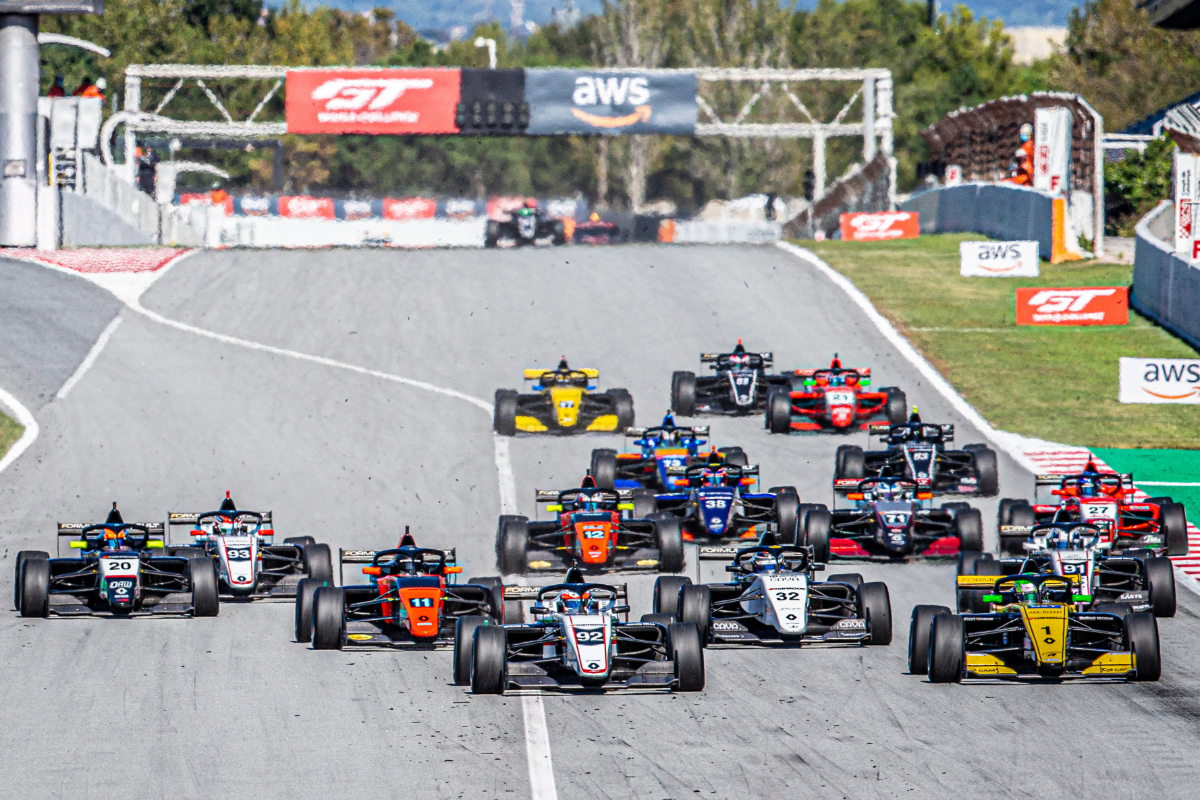
Photo: Clement Luck / DPPI
The Formula Renault Eurocup was as strong as ever this year, despite the COVID-19 pandemic, and other French-engined series also had a bit of a renaissance in Argentina, western Europe and Scandinavia
Off the back of a successful switch to Regional Formula 3 regulations in 2019, the Formula Renault Eurocup had much to look forward to in 2020. There was the return to the championship of junior single-seater powerhouse ART Grand Prix and Manor Competition, as well as the revamped Zandvoort circuit that had last hosted the series in 2000.
The year-defining pandemic then arrived, and Renault Sport was one of the very fastest to safeguard its calendar. It added Imola as it lost Silverstone, then after losing its Formula 1 support slot on the streets of Monaco it added another Imola round on the weekend F1 visited the circuit for the inaugural Emilia Romagna Grand Prix.
Rounds in Hungary and Abu Dhabi were also lost, but in came far cheaper alternatives at Magny-Cours and Hockenheim.
Manor’s return as the outfit behind the series’ Fernando Alonso-branded team didn’t happen on schedule either, with long-time partner MP Motorsport taking the running of those cars in-house from the start of the season and keeping the level of competition up, and when Arden’s Jackson Walls pulled out that handed Alex Quinn a seat that he was able to keep for the full season and make great use of.
The only loss of the season that didn’t have much of a silver lining was crack Toyota Racing Series team M2 Competition pulling out after the first two rounds and refocusing its efforts on 2021. But expect it to be near the front on its return.
Three of the top five drivers from 2019 returned, with title runner-up Victor Martins the firm title favourite despite switching from proven winner MP to ART GP – which was totally new to the Tatuus T-318 car but was quick in testing.

Photo: Clément Luck / DPPI
His main rival was expected to be R-ace GP’s Caio Collet, who was a winless fifth in 2019 but retained his Renault junior status as the rookie title winner while sophomore racer Martins won six races and lost his Renault links.
The season began at Monza with Quinn and MP’s Franco Colapinto stealing their thunder. Arden stand-in Quinn took pole for the season opener and led until Colapinto nabbed him after a safety car restart. Colapinto had become Quinn’s closest rival after a clash with Martins, which required the Frenchman to pit, and after taking the lead he drove well in defence for his first win. Quinn, who like Colapinto did a few rounds in 2019, finished second while Collet came third.
Martins was on pole for race two of the weekend, and like Quinn he was the race leader until the safety car bunched the field up. Collet fought his way through into the lead a few laps after the restart, bringing Colapinto with him, and with his first win he took the points lead.
The question of how Martins would respond to Collet’s win in the first bout was drowned out in round two at Imola, as car racing debutant David Vidales joined last-minute with JD Motorsport and made history by bagging pole for his debut and then taking two hugely impressive wins to rocket straight into third in the points. Martins meanwhile was sixth in the standings.
The title picture had changed by the end of the next round at the Nurburgring, where Martins dominated every session and even led a ART GP 1-2-3 in the second race there. Slow starts in both races hurt Collet, now five points off new leader Martins.
But unlike Martins’ average Imola showing, where most teams besides JD struggled with set-up, Collet’s response to Martins drawing ahead was to push him to the absolute limit next time out at Magny-Cours. In a joint interview during their title battle, both pointed to this weekend as being the closest they had been to each other in battle, and with a win apiece the gap at the front was brought down to two points. The only driver rivalling them there, and in the standings, was Vidales.
 It was a similar story at Zandvoort, where the top two got a pole each and then opened up huge gaps to the rest of the field while fighting for victory. But with matching results, there was no change in the title fight at the halfway point.
It was a similar story at Zandvoort, where the top two got a pole each and then opened up huge gaps to the rest of the field while fighting for victory. But with matching results, there was no change in the title fight at the halfway point.
Next up was Barcelona, Martins’ specialist circuit from his previous years in the Eurocup, and as expected nobody could match him over one lap let alone a whole race. Were it not for a safety car interruption in race two, he could have beaten Collet to victory by over 10 seconds in both races. Further down the order, MP’s debutant Kas Haverkort starred by finishing fifth.
In unique circumstances because of the pandemic, and the late addition of the F1-supporting Imola round, it meant the final four race weekends all ran one after the other. This was a gruelling physical and mental demand for the drivers, and the month-long trip started off on an odd note when Bhaitech driver Lorenzo Colombo had his nose injured during a mandatory COVID-19 test and had to miss the races at Spa-Francorchamps.
The Italian’s third season in the series had been a tricky one, with the move from MP to Bhaitech for 2020 moving him down the grid rather than up it. While initially frustrated at not being able to fight for the title, he seemed to find inner peace during his unusual absence and returned all guns blazing for the final three rounds at Imola, Hockenheim and Paul Ricard.
While he was gone, Martins extended his points lead again and Colapinto and Quinn came through to take wins in the rain.
Vidales was expected to throw another spanner in the works in the title battle on the second visit to Imola, but JD had lost its speed advantage and the Spanish teenager qualified eighth on his return. It was Colombo who took the first pole of the weekend, but a slightly messy race cost him a chance at victory and it was Collet who won. Vidales was hit out on the first lap.
It got even worse in race two, as Vidales turfed Collet into retirement on lap one while Martins took his record 15th series win and ended the weekend with a lead that had grown by 10 points. There was very little time for Collet to recover the gap.
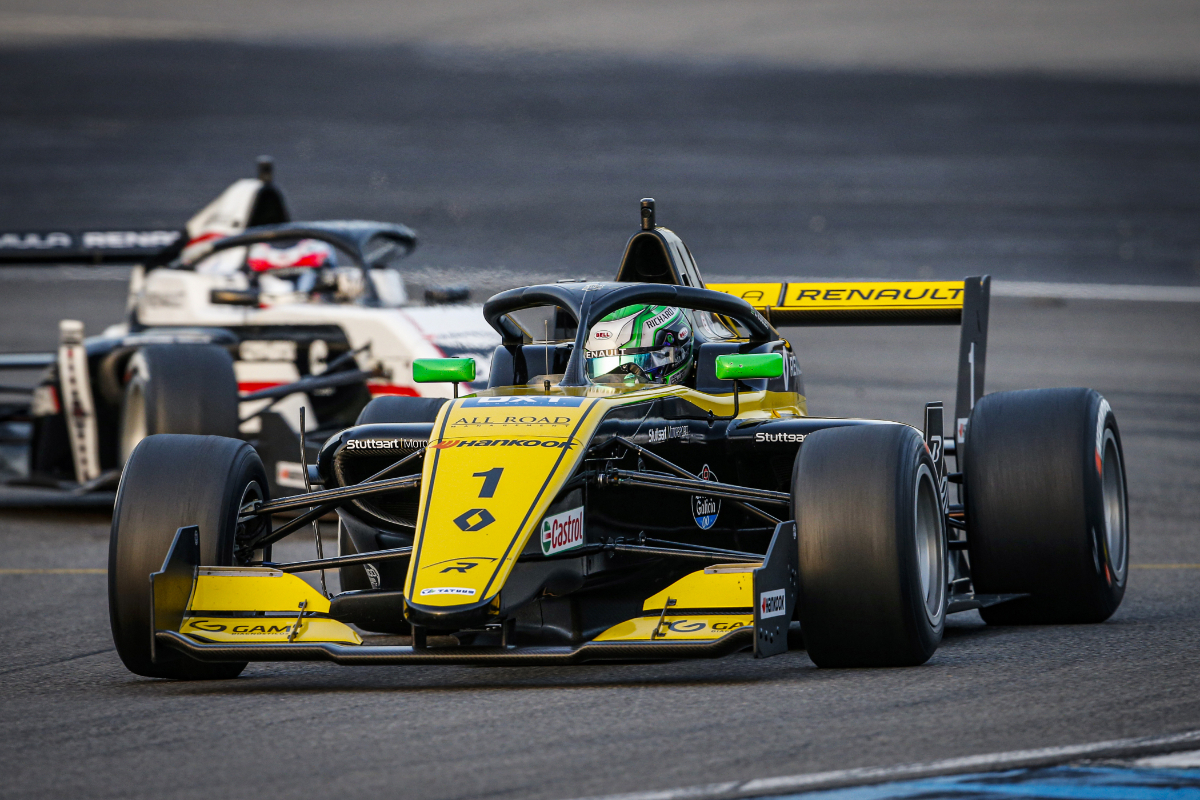 During that weekend it was announced that the Eurocup would be discontinued after 2020, as predicted by Formula Scout, and that its Renault engines would instead supply cars in the rival Formula Regional European Championship as of 2021.
During that weekend it was announced that the Eurocup would be discontinued after 2020, as predicted by Formula Scout, and that its Renault engines would instead supply cars in the rival Formula Regional European Championship as of 2021.
Collet went to the next round at Hockenheim and emphatically took pole, victory and fastest lap in race one to claim R-ace’s record 44th Eurocup win, but his Sunday began with a clutch change before qualifying and he ended up down the grid for race two – a race he failed to finish thanks to mechanical problems. Martins was a comfortable second in both races, as Colombo took Bhaitech’s first win on Sunday.
A 44-point gap existed between Martins and Collet ahead of the Paul Ricard season finale, and in the pre-event test Colombo and Martins set identical laptimes at the top while Collet was only 0.017s behind.
Martins broke the track record in free practice, where he was just 0.095s up on Collet, and the order went Colombo-Martins-Collet in both of the qualifying sessions.
Colombo was shadowed by Martins early in the season’s penultimate race, before the ART GP driver fell into the clutches of Collet – whose move for second on his rival was as pronounced as it was crucial. Martins lost another place to Colapinto, who now led Quinn and Vidales in the battle for third in the points, and with fourth place he secured the Eurocup title.
The 30th and final Eurocup season ended with another Colombo win, this time with Martins providing a challenge all race long, and resulting in Vidales losing fifth in the points to the Italian and losing the rookie title to Quinn.
Colombo’s late-season charge also brought him up to second place in the all-time list for points scored in the Eurocup, some 309.5 points behind Martins and 26 points ahead of Collet. Unfortunately nobody will ever get to rival those results in the future, although Renault has been linked to a formative concept of a Formula E feeder series…
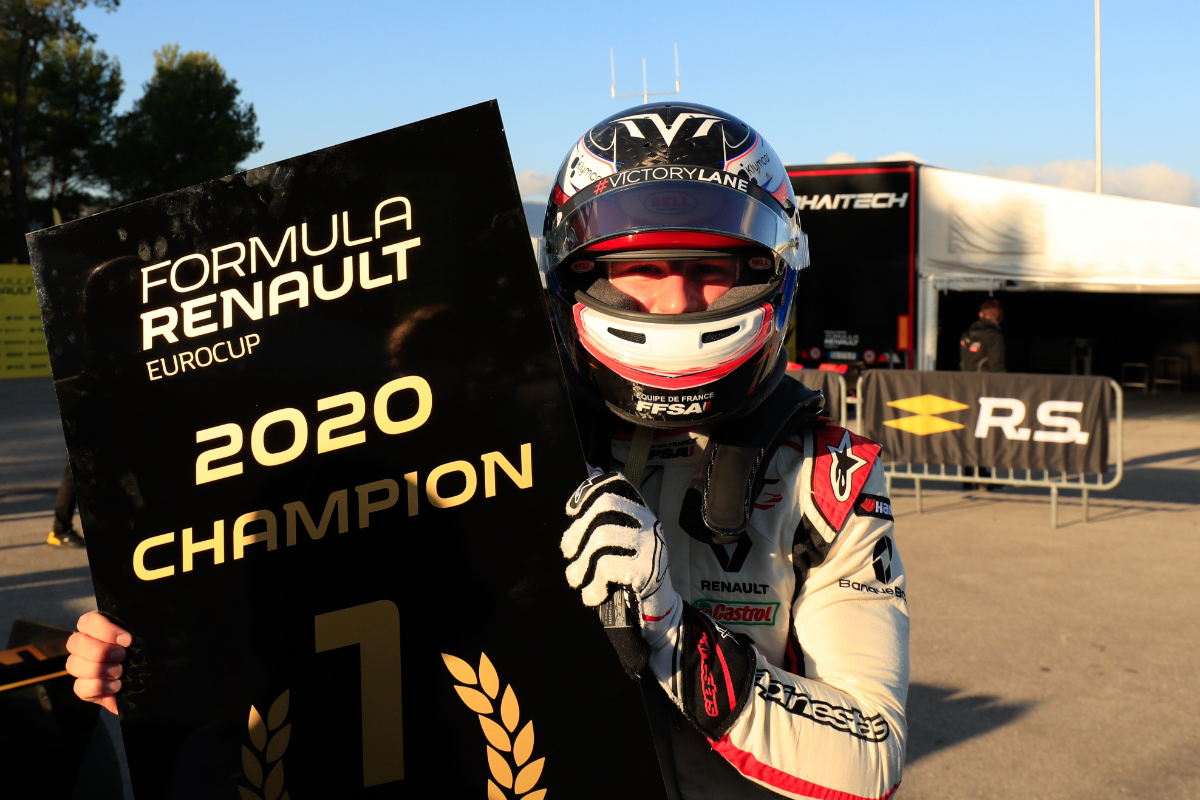 Formula Scout’s Top 5 Eurocup drivers
Formula Scout’s Top 5 Eurocup drivers
Key Percentage of team’s points scored (TP), Average qualifying position (QA), Average points per race (AP)
5. David Vidales SPAIN JD Motorsport
6th in standings, 169 points (2 wins, 1 pole, 2 fastest laps, 6 podiums) – TP 65%, QA 7.8, AP 9.4
Pole and victory on his car racing debut, in an international F3 race no less, then making the podium in six of his first seven races were simply spellbinding statistics by Vidales. He was one of the series’ top drivers as soon as he landed, having originally been headed to FREC with US Racing for his long-awaited single-seater graduation, and it was only when the paddock was pushed to its working limits in the four rounds running in a row that JD and Vidales’ form dropped.
Without the crashes on his Imola return he probably would have been fourth in the points, and had he done the full season he may well have been third.
4. Alex Quinn BRITAIN Arden
4th in standings, 183 points (1 win, 1 pole, 1 fastest lap, 5 podiums) – TP 67%, QA 6.4, AP 9.2
The Briton earned a top five spot in Formula Scout’s equivalent 2019 list, despite only doing three rounds, and it’s clear to see why. Arden was not the fastest team on the grid but Quinn got the maximum out of the car he had despite being called up late at the start of the season. His close relationship with the team no doubt helped and he finished in the top five in two thirds of the races. While Vidales moves to Prema for FREC 2021, Quinn should be joining him on the grid with Arden.
 3. Franco Colapinto ARGENTINA MP Motorsport
3. Franco Colapinto ARGENTINA MP Motorsport
3rd in standings, 213.5 points (2 wins, 2 fastest laps, 9 podiums) – TP 75%, QA 5.6, AP 10.7
The Spanish Formula 4 champion made the top 10 once in his two-round 2019 cameo, but Colapinto went straight to the top on his 2020 return. MP’s form seemed to waver quite a bit – Renault junior team-mate Hadrien David tended to be further off the pace at the same races Colapinto was – but he was on the podium at seven of the 10 rounds. His racecraft was exciting, but not always on point, and his focus was sometimes more on his coaching/engineering commitments in Spanish F4.
2. Caio Collet BRAZIL R-ace GP
2nd in standings, 304 points (5 wins, 3 poles, 4 fastest laps, 12 podiums) – TP 87%, QA 3.2, AP 15.2
Collet repeated what Martins did in his second Eurocup season, so you wonder if Renault will repeat the same mistake twice and drop him from its ranks. Recent comments from the Renault Sport Academy suggest not, and with good reason too. There were so many occasions where Collet was equal to Martins, or just a tenth behind, and you can put that gap down to experience. The Brazilian also got unlucky on several occasions, and the points gap probably should have been half of what it was.
1. Victor Martins FRANCE ART Grand Prix
1st in standings, 348 points (7 wins, 10 poles, 8 fastest laps, 14 podiums) – TP 74%, QA 1.9, AP 17.4
Returning to the Eurocup for a third attempt at the title was a risk, but Martins literally had no other options for 2020 so he took what he could and turned it into the title-winning season he came very close to against Oscar Piastri in 2019. The move to ART GP paid off handsomely, not only because of the success it brought this year but because it strengthens his chances of landing a FIA F3 promotion with the team next year – potentially alongside Collet too.
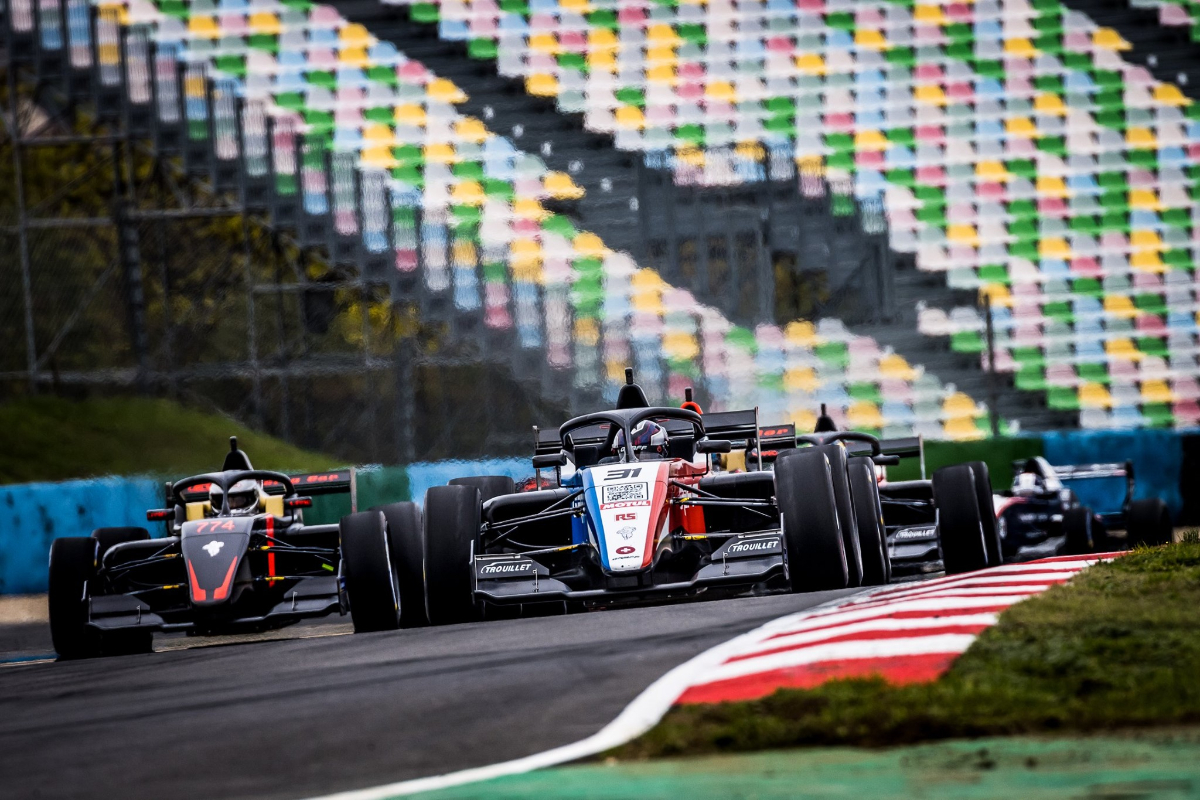
Photo: Ultimate Cup Series
Ultimate Cup Series
Created last year and slotting seamlessly into the place where VdeV Single-Seater Challenge – which launched the careers of Alex Peroni and Nico Varrone – had once been, the Ultimate Cup Series Single-Seater Challenge took on the mantle of Europe’s main FR2.0 series after the Eurocup abandoned the classic formula to adopt its current Regional F3 form.
But the ambitions of the people behind UCS went beyond being the pick-up of the all the last two generations of FR2.0 cars dotted around the continent, and it too brought in the Tatuus T-318 as the car for its top class. And given all of those cars had to use official Renault Sport engines, it in effect meant it became a three-class Formula Renault series.
European Le Mans Series team Graff Racing, which won the 2002 Eurocup with Eric Salignon, joined in and it had three drivers on the grid for the Dijon season opener. Nine Regional F3 cars and nine FR2.0 machines lined up for the first round.
On pole for the first race was Graff’s 17-year-old prodigy Konstantin Lachenauer. He’d only started karting in Switzerland in 2018, but was already making his single-seater debut in UCS by the end of 2019 and had signed up for the full 2020 season.
His team-mates were Graff’s gentleman drivers from sportscars, Lamo Racing had Corsican karter Pierre-Albert Fusella partnered by another two gentleman drivers in the top class, Formula Motorsport fielded two club racers alongside 2010 VdeV champion and Porsche Supercup backmarker Philippe Haezebrouck – who for reasons unknown raced under the pseudonym Steve Brooks – and Christophe Hurni raced for his own Sports Promotion team.
Hurni, previously the head of Swiss motorsport, is perhaps best known for racing in GP3 in 2011 when aged 48.
Back to the action.
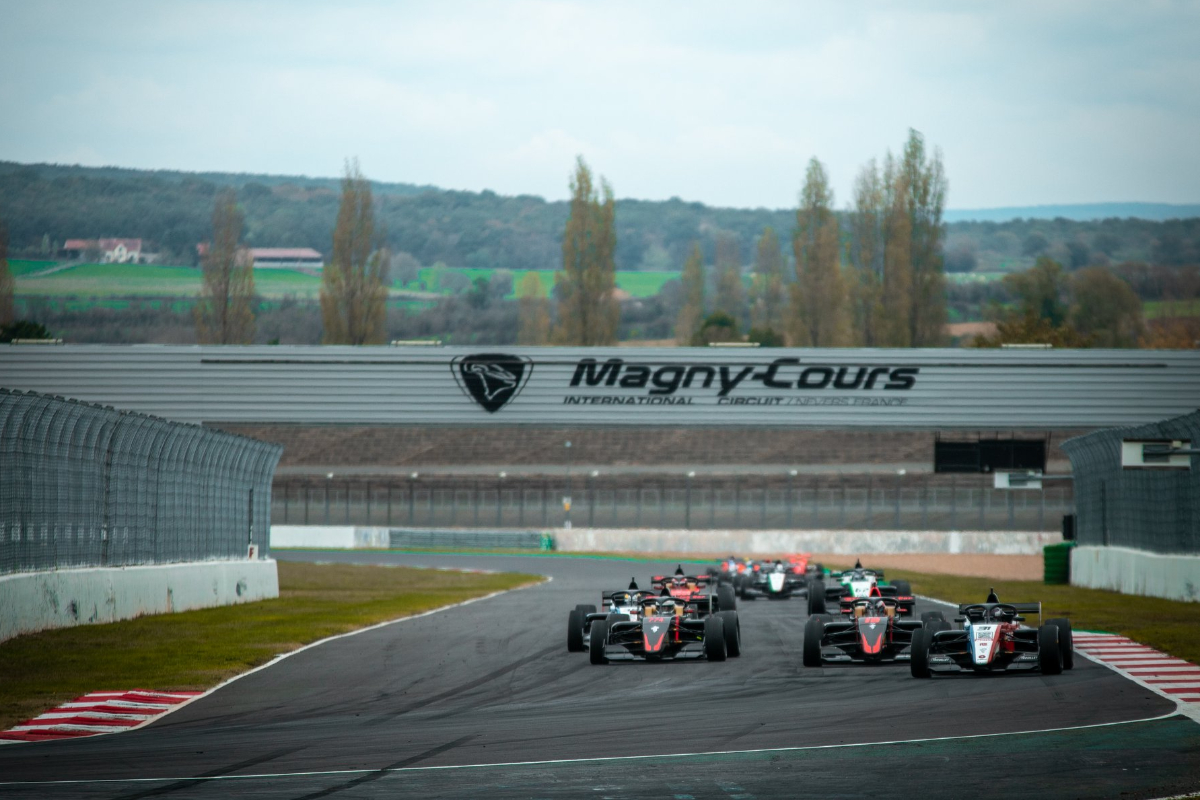 Lachenauer comfortably beat Hurni to victory in the season opener, and ended the weekend with victory and fastest lap from all three races. Under the guidance of ELMS LMP3 race-winner and 2015 VdeV champion David Droux he got even faster, and claimed another triple win at Magny-Cours. It was the same again on the return trip to the circuit, where he won race three by over 10s.
Lachenauer comfortably beat Hurni to victory in the season opener, and ended the weekend with victory and fastest lap from all three races. Under the guidance of ELMS LMP3 race-winner and 2015 VdeV champion David Droux he got even faster, and claimed another triple win at Magny-Cours. It was the same again on the return trip to the circuit, where he won race three by over 10s.
Rounds in Spain and Portugal, which were to run with higher points coefficients, were called off because of the pandemic and the season instead ended at Paul Ricard in December with another triple-header.
Formula Motorsport turned up with only one F3 car for the finale, but it was being driven by 2011 VdeV champion and new GT World Challenge Europe Silver Cup champion Simon Gachet, so Lachenauer finally had a challenge on his hands.
Lachenauer took pole by half a second over Gachet, and both were beaten off the line in race one by Lachenauer’s team-mate Adrien Chila after he massively jumped the start. Gachet and Lachenauer ended the opening lap in third and fifth, as Eric Trouillet led the chase of team-mate Chila. Gachet took the lead in a three-wide move at the Mistral chicane on lap three, then pulled away as Lachenauer took another two laps before he gained a spot and Chila was penalised.
After a side-by-side battle with Trouillet, Lachenauer finally made it up to second place on the penultimate lap but he ended up 16s down on Gachet. His weekend got harder as he had to start from the back in race two, only recovering to third place as Gachot claimed a 14s win, then stalling from third on the grid in the finale but finishing a not too distant second to Gachet to end a title-winning first year in cars.
Sports Promotion’s series sophomores David Kullmann and Loris Kyburz went into the final race fighting over the FR2.0 title. They were both beaten by TS Corse’s karter Gianluigi Palego in the finale, Kyburz finishing second and Kullmann becoming champion by four points in third place, having taken two wins in 12 races to Kyburz’s four.

Photos: Argentinian FR2.0
Argentinian FR2.0
The South American karting scene provided the top two in the 41st season of the Argentinian championship, although they were kept on their toes by the experienced Eduardo Moreno who was champion in the 1.6-litre class two years ago.
National lockdown meant racing didn’t get underway until late September, and it was Gabriel Werner Competition’s Lautaro Pineiro who claimed the first pole of the season at Buenos Aires.
The opening race took place on a damp track, and the safety car was required multiple times as drivers spun and clashed. Moreno emerged from the chaos to take a comfortable first win, ahead of Thomas Pozner and one of Argentina’s top junior karters Ayrton Chorne. There was more drama in race two, which was won by 2019 title runner-up Mateo Polakovich.
A month later the field headed to Autodromo Oscar Cabalen, and Moreno headed GW Competition’s Isidoro Vezzaro, who was karting in Europe two years ago, by just 0.089s in practice. He extended that advantage to a third of a second over Pineiro in qualifying, but in the early laps of the opening race it was Vezzaro who led Moreno.
Moreno then spun off, and when Pozner did the same the safety car was required. Vezzaro held off pressure from Croizet Racing’s Jorge Barrio to win. A wet and eventually muddy track made the second race of the weekend an even trickier contest, and Moreno redeemed himself by fending off Barrio to win.
The same track was used for round three a week later, and the top three were covered by just 0.051s in practice. Pineiro took pole again, with Barrio beating Vezzaro to second on the grid by 0.001s. All three were jumped by a driver from further down the field at the start of the race, but once they were cleared out the way it left the path open for Vezzaro to win.
He had to play second fiddle to Barrio in race two, but still extended his points lead ahead of the return to Buenos Aires where Spanish F4 part-timer Ignacio Montenegro joined the field.
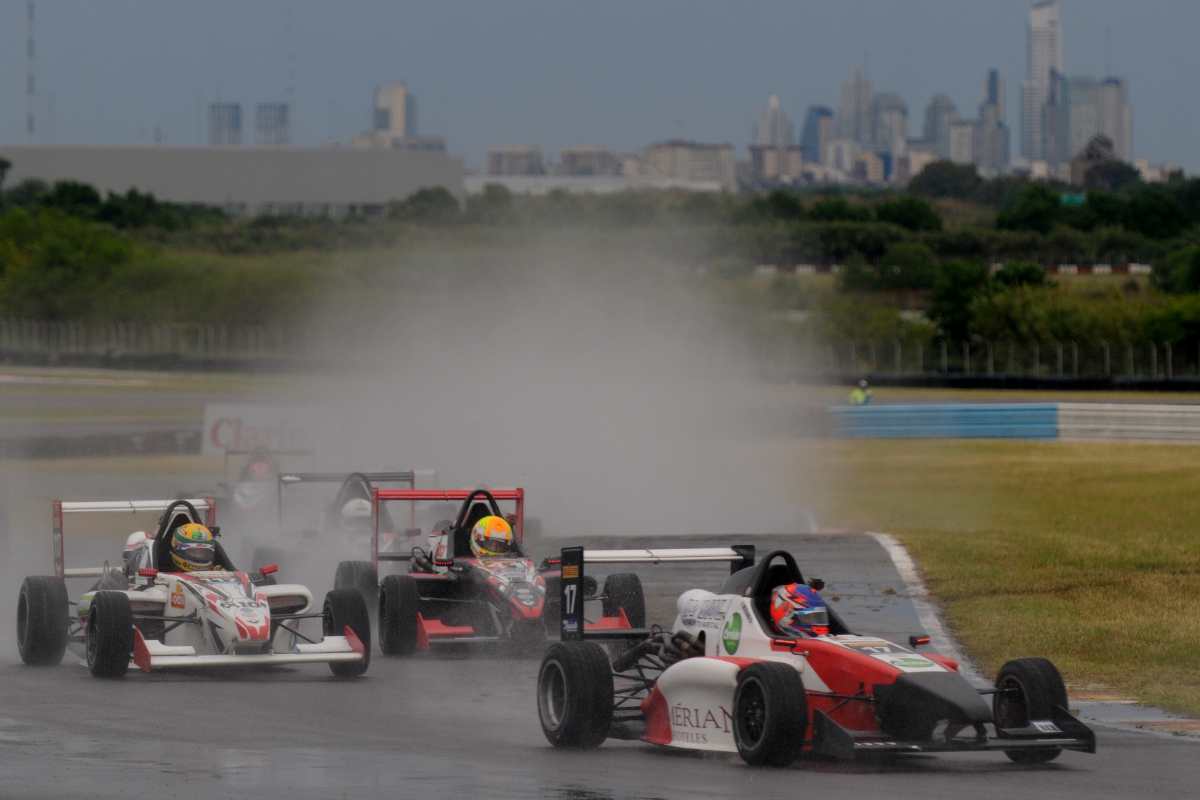 In soaking conditions Barrio bettered Vezzaro for pole, with Pineiro third, Polakovich fourth and Moreno fifth.
In soaking conditions Barrio bettered Vezzaro for pole, with Pineiro third, Polakovich fourth and Moreno fifth.
The circuit dried in time for the first race, but the drama ramped up as Barrio and Moreno slumped down the order while Polakovich and Pozner raced into the lead ahead of Vezzaro. Pozner retired in the second half but that didn’t help much, as Moreno and Barrio only recovered to fourth and sixth while Vezzaro extended his points lead by coming second to Polakovich.
Barrio led from the front in the final race, but Vezzaro sat behind him and banked the points for second place.
The season finale was scheduled to take place last weekend at Autodromo Uruguay, a circuit in Argentina that has been deemed unsafe to race on by the series. Whether Vezzaro will be crowned champion or another round will be organised is set to be announced imminently.
Formula Nordic
The currently Swedish-based series, where Linus Lundqvist started his career, was relaunched by its teams last year after its promoter it went bankrupt. Formula Nordic’s 2019 grids were small, but it bounced back in style with its FR1.6 cars in 2020.
Swedish junior karting graduate Joel Granfors took a double title win, and has since tested with Van Amersfoort Racing in F4 machinery. He missed the first round at Falkenberg though, and it was Havard Hallerud who dominated the first two races of the season.
Fifteen-year-old Granfors, who had tested the series’ car twice pre-season, had originally planned to enter in 2021.
His arrival at Karlskoga left an immediate impact, with pole (after Hallerud’s car failed to clear parc ferme) and two wins. The first of those wins was almost by 10s, while in race two a poor start meant he had to fight his way past Hallerud for a 8s victory. From sixth on the reversed grid in race three he was set for at least second place until a failed overtake for the lead dropped him to fourth.
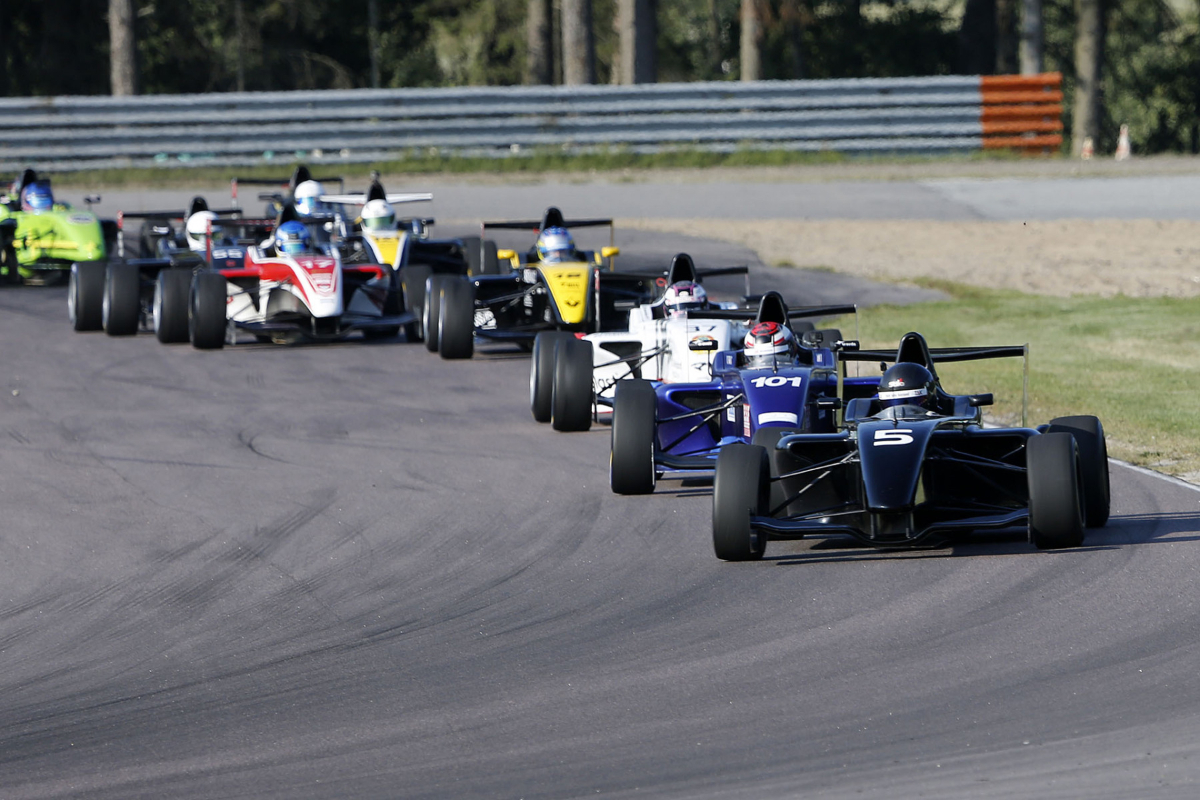
Photos: Formula Nordic
At Drivecenter Arena he did the triple, after Hallerud topped qualifying again but had car issues, but a combination of factors primarily out of his control left him down the grid at Anderstorp and with little chance of dominating. He was the top car on slick tyres in race two, when rain meant the grooved compound was required, and also won the reversed grid race.
Granfors’ first proper pole came at Mantorp Park, and he converted it into another win. He then spun a good result in race two, and Hallerud – whose season was being plagued by mechanical issues – closed the points gap to leader Granfors.
The two-race title showdown took place in the wet at Ring Knutstorp, and Hallerud beat Granfors to pole – and the five points that go with it – by 0.010s. Granfors got the title wrapped up in race one though, overtaking Hallerud on the opening lap to record an eighth win of the season and become overall and Junior champion.
After finishing fourth in the season finale, Granfors said his plan was still to race in FNordic in 2021, although being champion makes that a very unlikely prospect. A prize Danish F4 test, as well as his time with VAR, suggests F4 is the next step.
The rest
Austro-Hungarian junior karting graduate Oliver Michl won the poorly contested Austrian FRenault Cup with Gender Racing Team in his rookie year of cars. The grid peaked at three cars for the Monza season finale.
The FRenault Asiacup fared even worse, despite big plans for 2020. It planned to follow its European counterpart in bringing in F3 cars, while also allowing the old FR2.0 cars to continue to race so not to isolate its existing teams. The plan was when Asian F3 wasn’t running, the cars in that series would swap Alfa Romeo power for Renault and race in the Asiacup.
Entries were scarce, despite a support slot at the Vietnamese Grand Prix. The pandemic’s arrival meant that round got called off, as did a visit to Buriram in Thailand. A postponed three-round calendar based entirely at Zhuhai was then presented, and one-by-one those were called off until we were left with no season at all.
Further reading
Where Formula Renault is headed next, and how it got there
Ten of the best Formula Renault Eurocup seasons
In Conversation: Victor Martins & Caio Collet
Scout Report: Kas Haverkort
Ten of the best junior single-seater racing debuts
Why the FIA had to undo its confusing Formula Renault decision (April 2020)